Understanding the Cut Standards for Hand Protection: A Practical Guide
A safety professional’s role is to provide the support necessary to keep employees safe within their work environment. Identifying and correcting hazards and ensuring the employer is in compliance with regulatory requirements are certainly key responsibilities of a safety professional. Another key function is to provide injury-prevention measures that eliminate or reduce employee exposures to hazards while performing assigned tasks.
One effective way to identify and create preventive or protective measures against known hazards is through conducting a risk assessment. This process allows you and your employees to work together to identify all of the recognized hazards associated with a task or assignment followed by establishing controls that will protect employees when performing those tasks.
For many industries, one known hazard is exposure to cuts from handling materials. Hand injuries overall account for 15% of all injuries in the workplace. Research shows that cuts, punctures, and lacerations account for over 44% of hand injuries. Since we use our hands to perform critical life skills, any injury could be significant with loss of function, pain, and time needed to heal, hoping there is no permanent loss of function. Thus, cut-resistant gloves are a must-have in industrial work.
After following the hierarchy of controls to eliminate, substitute, and develop safe procedures that address the identified hand hazard, protection from remaining hazards is with personal protective equipment (PPE). The most common solution to cut exposures of the hands is cut-resistant gloves.
The problem is, what type of cut-resistant glove will work for the identified hazard? What glove will provide enough protection from the known hazard but not prohibit or reduce the ability to perform the assigned task?
In the market today, there are so many choices of gloves that are advertised as “cut-resistant.” We all know that depending on the hazard exposure, not all cut-resistant gloves are equal. How do we know that the glove we select offers the level of needed protection?
ANSI and CE EN Standards
There are two global organizations that safety professionals can rely on to provide testing results and ratings for cut-resistant gloves: the American National Safety Institute (ANSI 105) and the European Commission’s (CE) EN 388, the standard followed by Europe, Canada, Australia/New Zealand/Pacific, Mexico, and South America. Both standards were updated in 2016 and the testing for the gloves standardized using the International Standards Organization (ISO 13997) cut test method, which better aligns the results of the testing with more consistent and clear data.
ANSI revised the cut scores from a 1-5 rating (up until 2016) to 1-9, the higher the number, the more cut-resistant the glove. For industries with high risk cut hazards, expanding the cut-level rating allows for greater accuracy in matching the glove to the identified hazard.
The EN 388 standard continues with its 1-5 numerical rating for cuts that use the Coup test and adds an alpha-identifier (A-F) to align with and provide comparison to the ANSI 1-9 rating, using the ISO test.
The new glove markings, using the ISO testing standard, appear like this:
ANSI: Cut-level A9 = EN: Cut-level F
If you were familiar with the pre-2016 standard, you know the four EN numbers on a glove are for abrasion-resistance, cut-resistance, tear-resistance, and puncture-resistance. The second number – cut-resistance, was based on the Coup test method.
As the photo indicates, the new EN 388 six-digit display continues to follow the pre-2016 markings, but the “X” as the second digit means it was not tested for cut-resistance by the Coup method; the “F” (5th digit) means it was tested for cut-resistance using the ISO testing method. The “F” designation in EN 388 indicates the highest cut-resistance level and compares to the ANSI A9 marking.
An “Abrasion” rating may also appear on the glove. An ANSI rating will be in a separate marking, identified as “ABR” and the EN 388 standard will add a sixth alpha-digit after the cut-resistance letter, with a “P” (passed), an “F” (failed), or an “X” (not tested), as depicted in this chart.
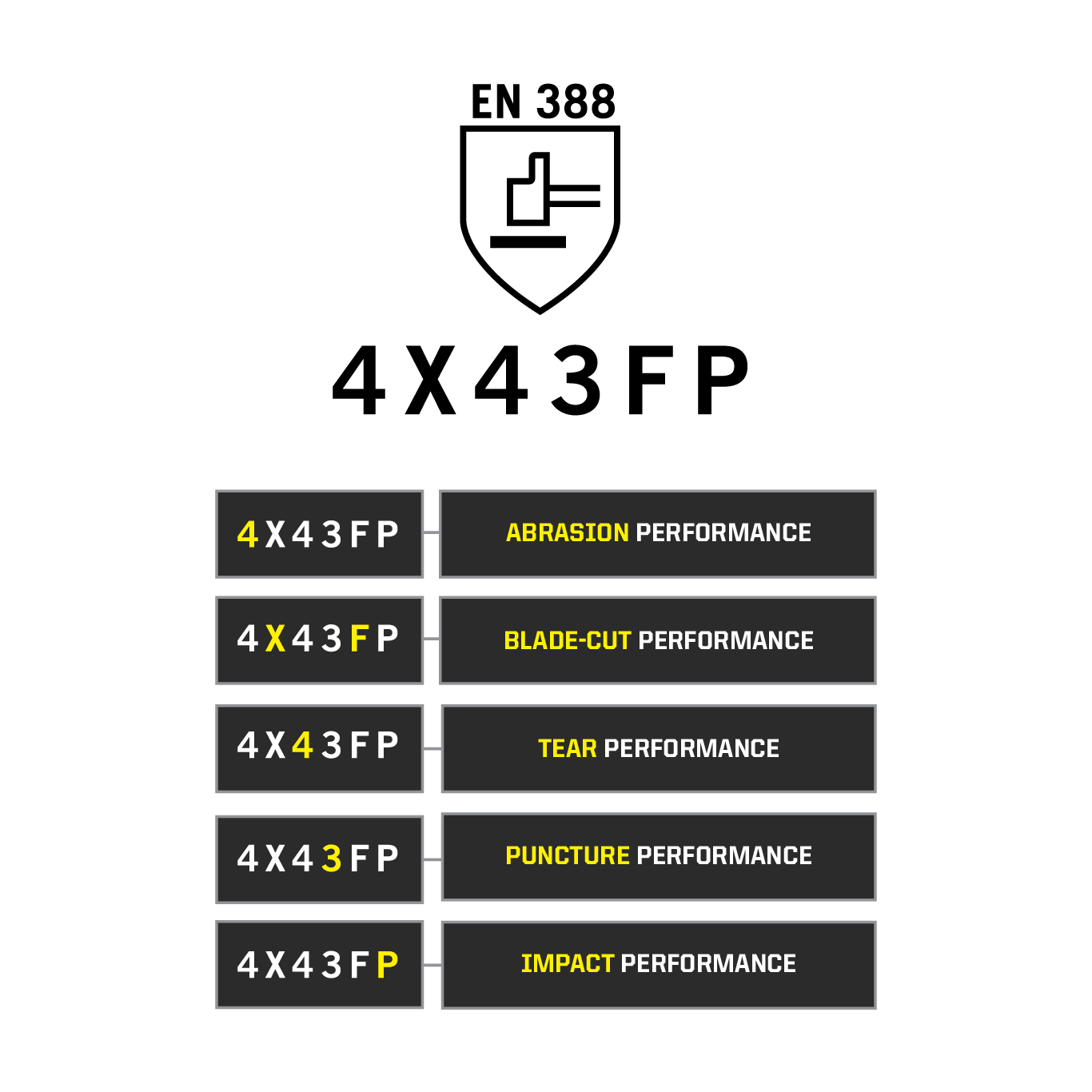
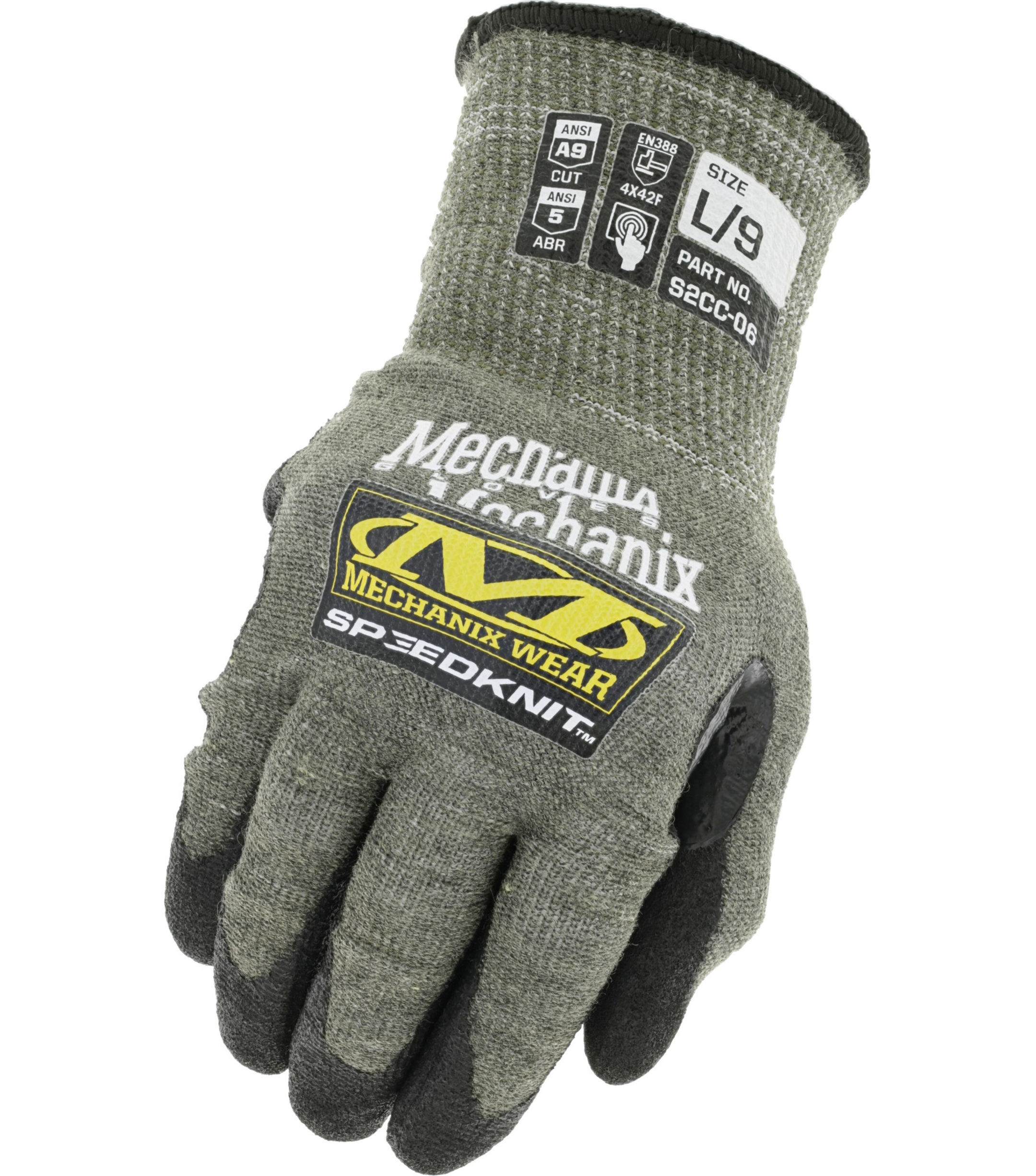
In a nutshell, as you conduct your risk assessment and determine the cut-level hazards, you can use the revised ANSI and EN markings to better select the right level of protection for the hazard.
The charts below offer a quick reference guide, regardless of how much you understand or know about the actual testing methods. You can also reach out to your manufacturer or distributor representative for assistance in your selection and needs (or just call us!).
Current ANSI Cut Levels Defined, using the TDM 100 (ASTM) test:
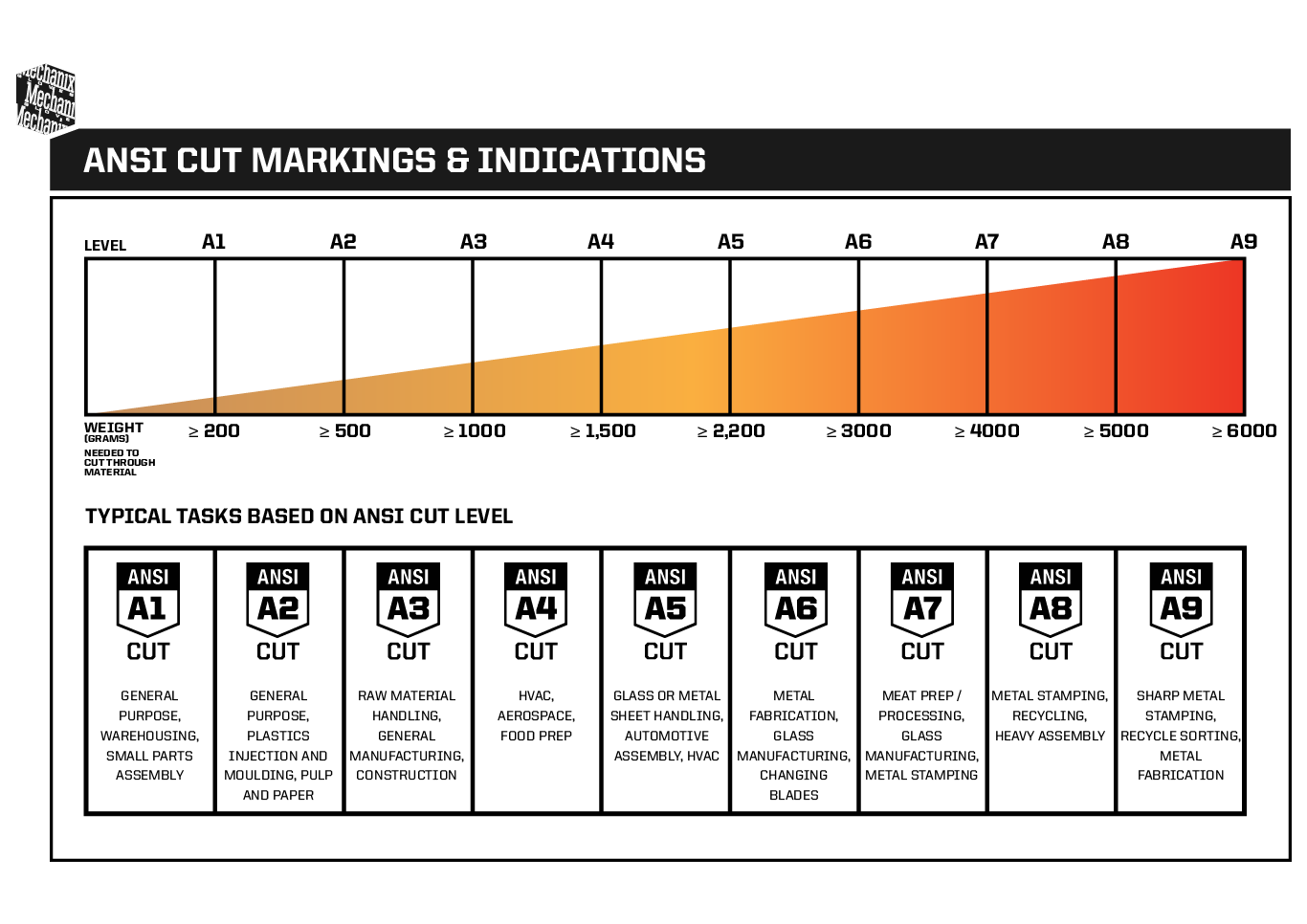
Current EN Cut Levels Defined, using the Coup Test (2nd digit) and TDM 100 test (5th digit):
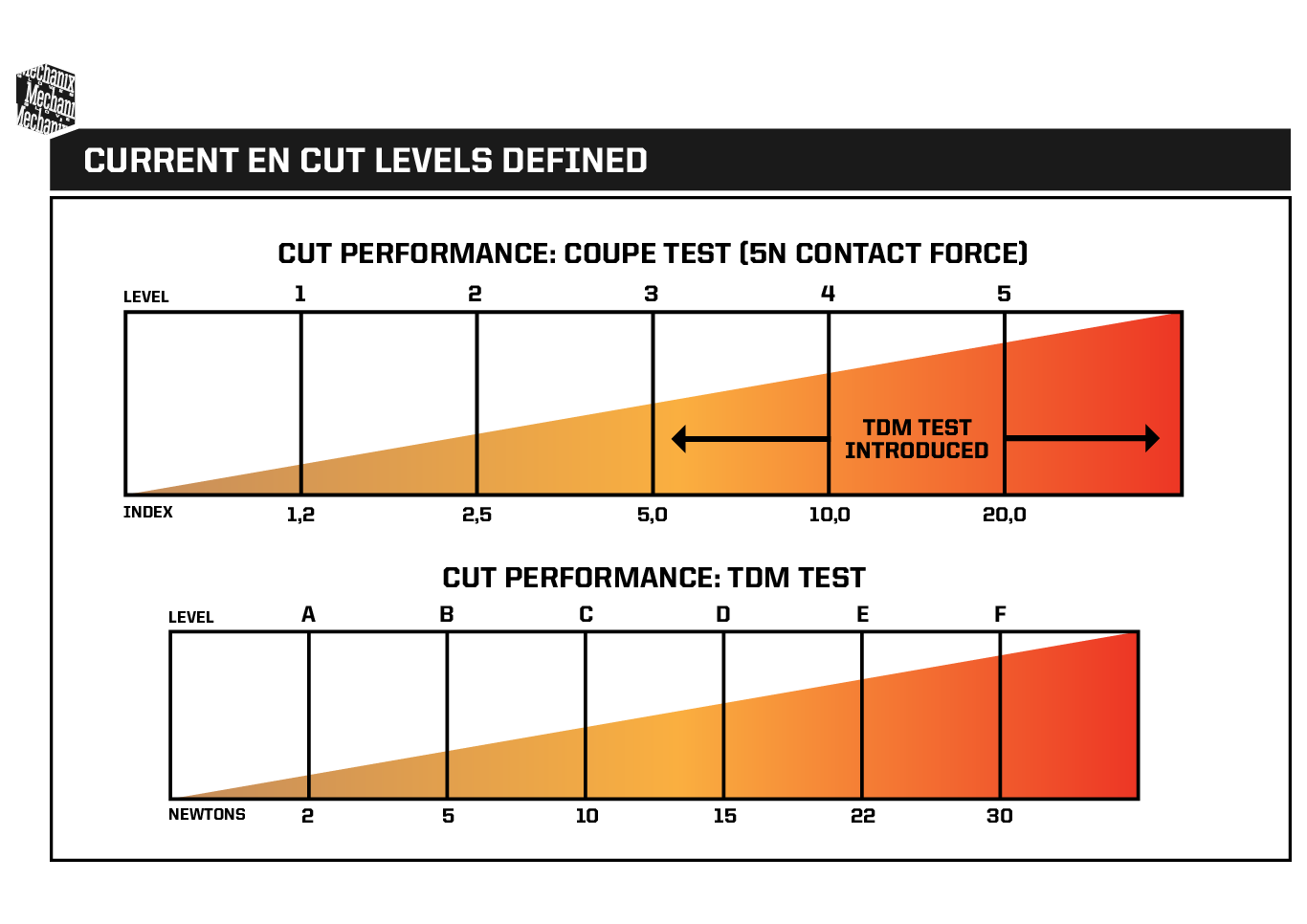
Remember, it is your responsibility to select the PPE that best protects from the hazards identified in your risk assessment. The wrong glove – whether insufficient or over-rated for the hazard – can create additional hazards while providing a false sense of protection for your employees.
Matching the correct glove and protection level to the hazard will reduce your frequency and severity of injuries, reduce your injury and workers’ compensation costs, and actually save your budget and your profits by purchasing the right PPE. Price point alone should never be your guide as buying the least expensive item generally proves to be very expensive in the long run. Base your selection on form, fit, and function for the identified hazard.
Cut-Resistant Glove Tests and Scores
Both ANSI and the CE revised their cut glove testing standards in 2016 to provide synchronization between testing and scoring. This synchronization provides clarity for the end-user to select the glove most appropriate for the identified hazards.
The global standards address the testing and classification of hand protection gloves for the following performance properties):
- Mechanical Protection:
- Cut Resistance
- Puncture Resistance
- Abrasion Resistance
- Chemical Protection:
- Permeation Resistance
- Degradation
- Other Performance Characteristics:
- Ignition Resistance
- Vibration Reduction
How Does the Test Work?
The ANSI/ISEA 105 and EN 388 are now synchronized by both organizations following the ISO 13997 standard using the Tomodynomometer machine (TDM 100) test. This allows for the end users to compare cut-resistant levels knowing the testing for each standard is the same.
Pre-2016, each standard followed different test methods: the TDM method uses grams (mass) of weights applied vertically with a horizontal cutting motion to measure how much a glove could withstand from a sharp blade prior to penetrating it. The greater the grams, the more weight that is needed to cause a glove to be damaged.
The Coup method uses newtons (force) with a circular cutting motion to measure how much applied energy was needed to cause damage to the glove. The greater the newtons, the more force that is needed to cause a glove to be damaged.
TDM100 and Coup Comparison


Here is a comparison chart that depicts the differences between the ISO 13997 standard and the ANSI 105 (TDM 100) and EN 388 (Coup) tests.
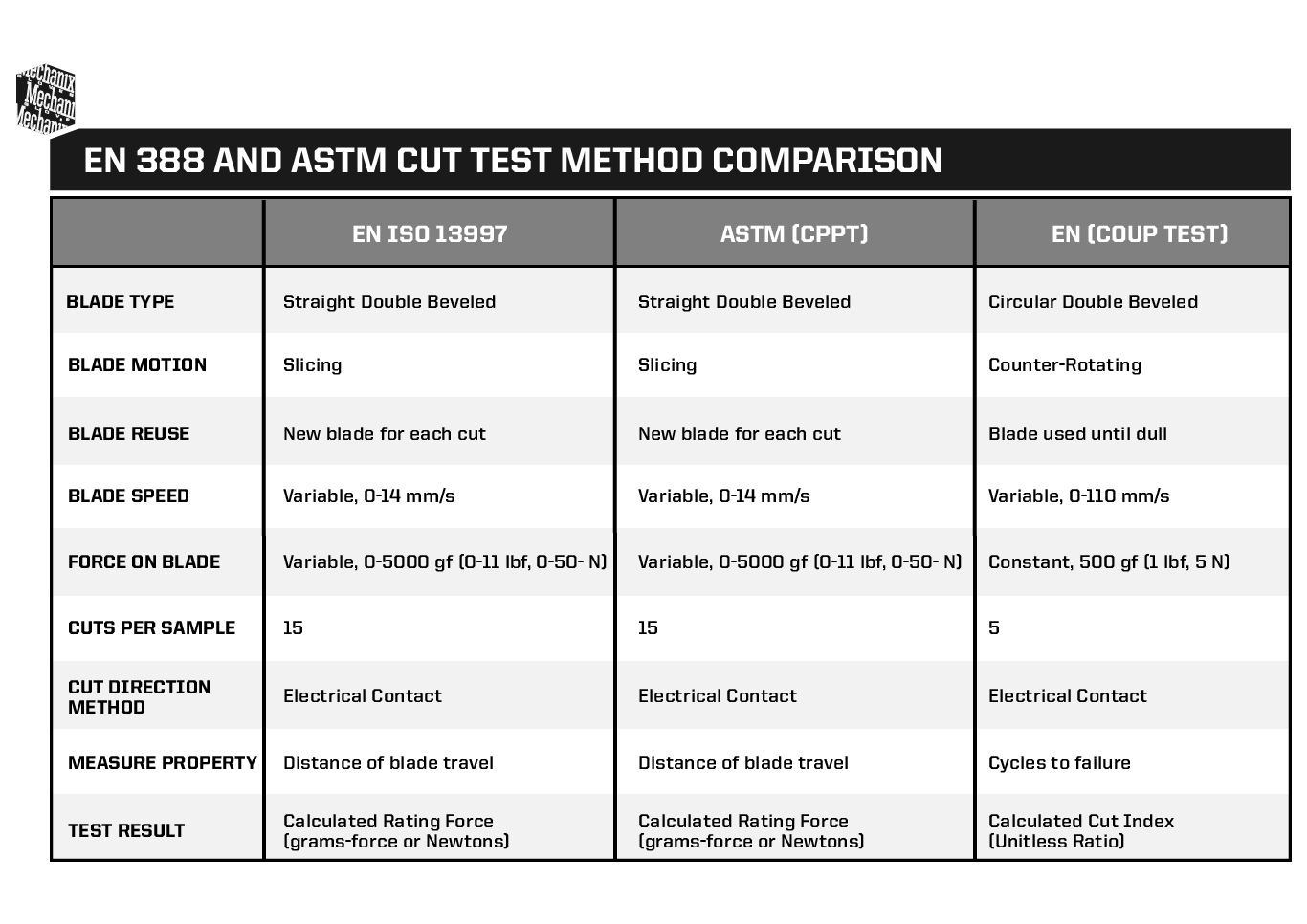
How Do Manufacturers Label Cut Scores?
The ANSI cut-resistant gloves are displayed on the glove or tag using an “A” followed by a number, 1-9, such as A3 or A8. This score is derived from using the ASTM TDM 100 test method. EN388 cut-resistant gloves following the Coup test uses a numerical score, 1-5, depending on the cut-resistance level (the 2nd digit of the displayed EN score), whereas the TDM-100 scoring on an EN 388 marking appears in ranges from A to F (the 5th digit of the displayed EN score).
What are the Different ANSI Cut Levels?
In 2016, International Safety Equipment Association (ISEA) and ANSI released an updated scale with nine levels of cut protection to measure performance. These levels indicate the grams of cutting load the gloves can bear from a sharp blade before penetrating.
- A1: 200 - 499 grams–it protects light cut hazards
- A2: 500 - 999 grams–it offers light to medium protection from cut hazards
- A3: 1000 - 1499 grams–it provides light to medium cut protection
- A4: 1500 - 2199 grams–it protects against medium-cut hazards
- A5: 2200 - 2999 grams- it offers medium to heavy protection from cut hazards
- A6: 3000 - 3999 grams–it protects from high cut hazards
- A7: 4000 - 4999 grams–it covers high cut hazards
- A8: 5000 - 5999 grams–it gives high cut protection
- A9: 6000+ grams–it offers protection from high cut hazards
What are the EN 388 Cut Levels?
Here are the EN 388 cut levels and the associated ANSI grams with examples for which these levels might apply:
- A: 2 - 4.9 newtons (204 - 508 grams) – light material handling; small part assembly
- B: 5 - 9.9 newtons (509 - 1019 grams) – packaging; warehousing
- C: 10 - 14.9 newtons (1020 - 1529 grams) – maintenance; metal handling; light assembly
- D: 15 - 21.9 newtons (1530 - 2242 grams) – engineering; automotive; electrical installation
- E: 22 - 29.9 newtons (2243 - 3058 grams) – metal stamping; glass manufacturing; automotive assembly; waste management
- F: 30+ newtons (3059+ grams) – pulp/paper; heavy metal stamping; glass handling; waste management; recycling

Choosing the Right Cut-Resistant Glove
Choosing the right pair of gloves for a particular job can be challenging, with numerous options available. Since many hand injuries result from using the wrong pair of cut-protection gloves, it is essential to consider the following factors to avoid accidental cuts.
Understanding Glove Materials
The first step in choosing the right pair of cut-resistance gloves is to select suitable material. Choosing the right material ensures comfort and protection. If you select a itchy, hot, and uncomfortable pair of gloves, you cannot wear them for long, and will be prone to remove them.
There is a wide variety of Mechanix Wear gloves: coated-knit work gloves, leather impact-resistant gloves, general purpose work gloves, high-visibility cut-resistant winter gloves, and many more. Check the website to easily skim through and choose the right pair of gloves that will offer comfort and protection from cuts and tears. Or ask us for detailed recommendations.
Choosing Your Grip
Another critical factor in choosing the right pair of gloves is the grip. If you work in oily or wet conditions, you’ll need gloves with a firm grip. However, many glove types promise a firm grip but fail in oily conditions. Mechanix Wear offers gloves that provide a firm grip and deliver on their promise.
The Bottom Line
Protective gloves protect against wear, cuts, and tears. With several options available, choosing the proper glove can be difficult. Consider the essential factors when selecting the right pair of gloves for the tasks performed. Mechanix Wear offers an extensive line of protective gloves with different protection levels. We can help ensure work happens safely and comfortably.
FAQ
Q1. Are the ANSI/ISEA 105 AND EN 388 cut standards the same?
No. The ANSI/ISEA 105 and EN 388 cut standards are different. While the cut standard is established using the same testing methods and machines, the scores reported are in other units of measurement; where ANSI/ISEA 105 uses grams to measure performance and EN 388 uses Newton and gram to measure performance.
Q2. How can you determine the correct glove size and length to ensure cut-resistant protection?
You can determine the correct glove size by measuring the circumference of your hand (suitable for right-handed people and left for left-handed people) near the base of your knuckles with a flexible tape measure. The measurement correlates with the numerical glove size. In some cases, the gloves' length varies depending upon the tasks performed and the protection required. Moreover, you can use a flexible measuring tape to measure the arm's length starting from the middle finger's tip. Here’s a handy glove sizing guide to help.
Q3. What protection level should my selected gloves provide?
It truly all depends on the application and work being performed. While choosing protective gloves, one must consider the hazards involved. Nitrile gloves protect against chemicals and infectious agents, where as neoprene gloves protect from oils, solvents, and mild corrosive materials. Leather gloves protect against a whole different set of hazards… knowing the application and environment is critical in ensuring proper hand protection.
Mechanix Wear can take away the guess work (or time-consuming work) and make the selection process much easier for you. Need help selecting (or verifying) the right gloves for your workplace and different applications – we can help.